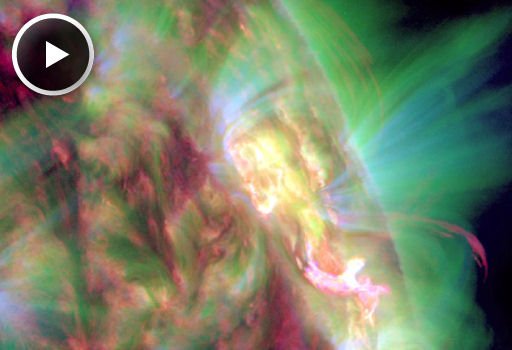FULL SNOW MOON: There's a full Moon tonight. According to folklore it is the "Snow Moon," named by Native Americans after the heavy snows of February. In North America, snow has been in short supply, but the white tide is turning in Europe as winter storms sweep across the continent. Wherever you are, enjoy the cold moonlight.
M-CLASS SOLAR FLARE: Departing sunspot AR1410 is growing in size and magnetic complexity as it approaches the sun's northwestern limb. The region is now crackling with solar flares, highlighted by this M1-class eruption on Feb. 6th at 20:01 UT:
NOAA forecasters estimate a 30% chance of more M-flares during the next 24 hours. Any eruptions from AR1410 are unlikely to be Earth-directed as the active region continues to turn away from our planet. Solar flare alerts: text, voice.
AURORA WATCH: Earth passed through a minor solar wind stream on Feb. 4-5. The weak impact of the solar wind was just enough to spark auroras around parts of the Arctic Circle. Frank Olsen sends this 20-second exposure from the waterfront outside Tromsø, Norway:
"Despite bright moonlight and low solar activity, there were some great auroras last night," says Olsen.
The effects of the solar wind are subsiding, and the auroras might disappear into the moonlight for the next few nights. Geomagnetic activity is expected to hover at low levels for the next 48 hours.
more images: from Oivind Toien of Fairbanks, Alaska; from Fredrik Broms of Kvaløya, Norway

![]()
Solar wind
speed: 479.6 km/sec
density: 0.1 protons/cm3
explanation | more data
Updated: Today at 1335 UT
![]()
X-ray Solar Flares
6-hr max: C5 1103 UT Feb07
24-hr: C5 1103 UT Feb07
explanation | more data
Updated: Today at: 1300 UT
![]()
![]()
![]()
Daily Sun: 06 Feb 12
![]()
![]()
A new cluster of spots is growing just north of AR1410. Credit: SDO/HMI
![]()
![]()
![]()
Sunspot number: 27
What is the sunspot number?
Updated 05 Feb 2012
Spotless Days
Current Stretch: 0 days
2012 total: 0 days (0%)
2011 total: 2 days (<1%)
2010 total: 51 days (14%)
2009 total: 260 days (71%)
Since 2004: 821 days
Typical Solar Min: 486 days
Updated 05 Feb 2012
The Radio Sun
10.7 cm flux: 103 sfu
explanation | more data
Updated 05 Feb 2012
![]()
![]()
![]()
Current Auroral Oval:
![]()
Switch to: Europe, USA, New Zealand, Antarctica
Credit: NOAA/POES
![]()
![]()
![]()
Planetary K-index
Now: Kp= 3 quiet
24-hr max: Kp= 3 quiet
explanation | more data
![]()
Interplanetary Mag. Field
Btotal: 6.9 nT
Bz: 3 nT south
explanation | more data
Updated: Today at 1336 UT
![]()
![]()
![]()
Coronal Holes: 06 Feb 12
![]()
![]()
Solar wind flowing from this coronal hole should reach Earth on or about Feb. 10th. Credit: SDO/AIA.






